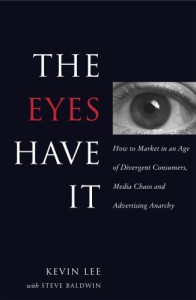Ask anyone who writes white papers for a living and they’ll tell you that sometimes the little buggers get out of control. What started out as a 12-pager on sprinkler flow testing best practices ends up at 25 pages without much warning. Sort of like that adorable alligator in the pet store. So when Kevin Lee and Steven Baldwin lost control of their anti-agency rant paper and it ended up at 189 pages, they did what any good marketer would do: they slapped a couple of covers on that sucker and called it a book, and called that book The Eyes Have It.
Too bad it’s horribly written, not particularly enlightening and seems to have been edited by a packet of jam.
Things started out hopefully enough with this intriguing bit of prose on page nine:
“The insurgent spirit of the nascent medium was aptly captured by colorful visionaries such as John Perry Barlow, who in 1996 wrote the ‘Declaration of Independence for Cyberspace’, an audacious document declaring that the Web consisted of a completely new society with its own morays (yay, eels!), rules, and spirit that would bow  neither to the time-worn rules of the media establishment or (really?) the will of duly authorized regularity bodies.” (who knew?).
neither to the time-worn rules of the media establishment or (really?) the will of duly authorized regularity bodies.” (who knew?).
Alas the morays took their laxatives and went home, leaving the sophomoric eyes theme to be flogged to death in the chapter titles and a proliferation of words like silo’d (which isn’t actually a verb so I suppose they can spell it anyway they want). But I’m being pedantic. Let’s dive into the content; let’s learn about this media chaos and advertising anarchy! Let’s nail this search engine marketing thing.
Now I’m no fan of the ad agency culture that believes its own mythology but by the end of Chapter One I was beginning to pity them a little. Sure, as the authors correctly observe, agencies were slow off the mark around all things web, particularly SEM. And yes, they continue to cling to their media-as-blunt-instrument model: “Buy time in big blocks from the networks, mark it up, and pocket the check…” And yes, as media consumption fragments, content needs to adapt, but the idea that “…creating customized messages capable of being perceived as relevant by a demassified audience is not easy…” and then suggesting that your agency probably isn’t bright enough to help you is maybe just a little self-serving. The authors do concede that if the smart young agency people throw out the stupid old agency people and then buy a cheeky little digital agency, then hope is permitted to live.
Chapter Two evokes its white paper origins with some astonishingly awful charts and graphs. I’m not sure what the graphics are meant to demonstrate but it would appear they are there in support of the notion that SEM is difficult and complicated charts prove that fact. Why they look like a default cut and paste out of Excel is beyond me. There is an interesting romp through early search engine history and then we get back to slapping agencies upside the head with statements like this one: “Today, uttering the word ‘Google’ in the presence of ad men has the same effect that mentioning the work ‘cancer’ has in a doctor’s waiting room.” Excuse me while I check for a Googleous lump.
We also find out that the lack of formal training resources for SEM marketers means most companies are screwed because their SEM team is under-skilled, overworked and distracted and not supported by their incompetent agencies. Speaking of agencies, the rant continues for another few chapters with the revolting reference to people as “wetware” and we are delivered at last to some solutions to this intractable problem of stupid people trying to do a difficult thing. You need to build some models to measure online interaction with your brand. Metrics like time on site, page views, registrations, downloads and, get ready, Branding Effectiveness Index (BEI for short) (pronounced “buy”). I don’t know if this is a seminal moment in SEM or not because I was laughing so hard at this point, the rest of the chapter went BEI in a bit of a snotty blur. If memory serves, there were some brief ideas about how top brands might build a BEI. Probably worth another look.
The grand finale is more agency abuse and some reminders about paying attention to platforms and keyword choices. There is an unfortunate “change is the only constant” quote for which both authors should be slapped and a conclusion that is a terrible blizzard of clichés and glimpses of the obvious.
To be fair, this book is a few years old, and some of the weirdness of the early days of SEM have come and gone. But it’s very difficult to get past the terrible writing, self-indulgent agency bashing and condescending view of most marketers as drooling morons to find any helpful advice. And the eels, sadly, never come back.
Related Posts
Why Meaning Matters More Than Noise
To Everything Spin, Spin, Spin
BizMarketer is written by Elizabeth Williams
I help companies have better conversations
Drop me a line at ewilliams@candlerchase.com
Or follow me @bizmkter
Does demassification mean the social morays are all going their own way? I’m not sure if this affects me or not, but I’m pretty sure I’ll be sniggering all afternoon now. Stoopid old agency people…..a bodacious document you say? Sorry, I guess that was an audacious document.